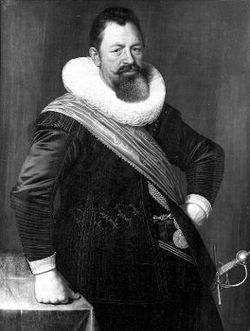
Jochem Hendrickszoon Swartenhont
Encyclopedia

Amsterdam
Amsterdam is the largest city and the capital of the Netherlands. The current position of Amsterdam as capital city of the Kingdom of the Netherlands is governed by the constitution of August 24, 1815 and its successors. Amsterdam has a population of 783,364 within city limits, an urban population...
– 5 June, 1627) was a Dutch naval officer in the navy of the Dutch Republic
Dutch Republic
The Dutch Republic — officially known as the Republic of the Seven United Netherlands , the Republic of the United Netherlands, or the Republic of the Seven United Provinces — was a republic in Europe existing from 1581 to 1795, preceding the Batavian Republic and ultimately...
from the 17th century.
Swartenhondt started his career on the merchant fleet, becoming a cabin boy at age eleven. He attained the rank of first mate. Later he joined the army to fight against the Dunkirkers
Dunkirkers
During the Dutch Revolt the Dunkirkers or Dunkirk Privateers, were commerce raiders in the service of the Spanish Monarchy. They were also part of the Dunkirk fleet, which consequently was a part of the Spanish Monarchy's Flemish fleet ...
but in 1587 he was captured and forced to serve on the Habsburg galleys in Flanders; he managed to escape however and brought with him important intelligence about the Spanish Armada
Spanish Armada
This article refers to the Battle of Gravelines, for the modern navy of Spain, see Spanish NavyThe Spanish Armada was the Spanish fleet that sailed against England under the command of the Duke of Medina Sidonia in 1588, with the intention of overthrowing Elizabeth I of England to stop English...
of 1588.
In 1596 he became a lieutenant with the Amsterdam admiralty; in 1597 a captain.
In 1599 he distinguished himself while serving as captain of a ship in a fleet under Vice-Admiral Pieter van der Does
Pieter van der Does
Pieter van der Does was a Dutch naval commander. He was the son of Jacob van der Does , schepen of Leiden during its siege.-Life:...
during an expedition to Gran Canaria
Gran Canaria
Gran Canaria is the second most populous island of the Canary Islands, with a population of 838,397 which constitutes approximately 40% of the population of the archipelago...
. In 1602 he became a Vice-Admiral with the Amsterdam Admiralty and served under Admiral Jacob van Wassenaer-Duivenvoorde on an expedition to the Spanish coast. From 1603 to 1605 he served as a temporary Vice-Admiral under Paulus van Caerden
Paulus van Caerden
Paulus van Caerden was a Dutch admiral in service of the Dutch East India Company. He was governor of the Maluku Islands for one month....
during an expedition to the West Indies and Brazil
Brazil
Brazil , officially the Federative Republic of Brazil , is the largest country in South America. It is the world's fifth largest country, both by geographical area and by population with over 192 million people...
. In 1605 he ended his service, becoming an inn-keeper, but in 1608 again was readmitted as a temporary Vice-Admiral.
He was painted, wearing his military decorations, by Nicolaes Eliasz Pickenoy (1588–1655), who also painted Jochem's daughter Maria.
At the start of the Twelve Years' Truce
Twelve Years' Truce
The Twelve Years' Truce was the name given to the cessation of hostilities between the Habsburg rulers of Spain and the Southern Netherlands and the Dutch Republic as agreed in Antwerp on 9 April 1609. It was a watershed in the Eighty Years' War, marking the point from which the independence of the...
in 1609 he again retired from service. From 1609 to 1620 he and his wife, Elisabeth Jacobs Bas (1571-1649), would keep the Prins van Oranje ("Prince of Orange") tavern in Amsterdam, a popular watering hole of many politicians, artists, and writers. After Jochem's death his widow Elisabeth Bas
Elisabeth Bas
Elisabeth Bas was a figure in the Dutch Republic. She was the wife of Jochem Hendrickszoon Swartenhont....
sold it, becoming rich (she left 28,000 guilders on her death). Ferdinand Bol
Ferdinand Bol
Ferdinand Bol was a Dutch artist, etcher, and draftsman. Although his surviving work is rare, it displays Rembrandt's influence; like his master, Bol favored historical subjects, portraits, numerous self-portraits, and single figures in exotic finery.The street Ferdinand Bolstraat in Amsterdam was...
made a well-known painting of Elisabeth in 1640, many years after Joachim's death.
In 1620, when the truce was about to end, at his own request Jochem returned to the fleet as a Vice-Admiral; in 1621 he became Lieutenant-Admiral of Holland and West-Friesland and he commanded a large convoy
Convoy
A convoy is a group of vehicles, typically motor vehicles or ships, traveling together for mutual support and protection. Often, a convoy is organized with armed defensive support, though it may also be used in a non-military sense, for example when driving through remote areas.-Age of Sail:Naval...
to the Mediterranean and successfully defended it against an attack by a Spanish squadron. In 1622 he acted as temporary Lieutenant-Admiral; after that year he left the naval service for good.

